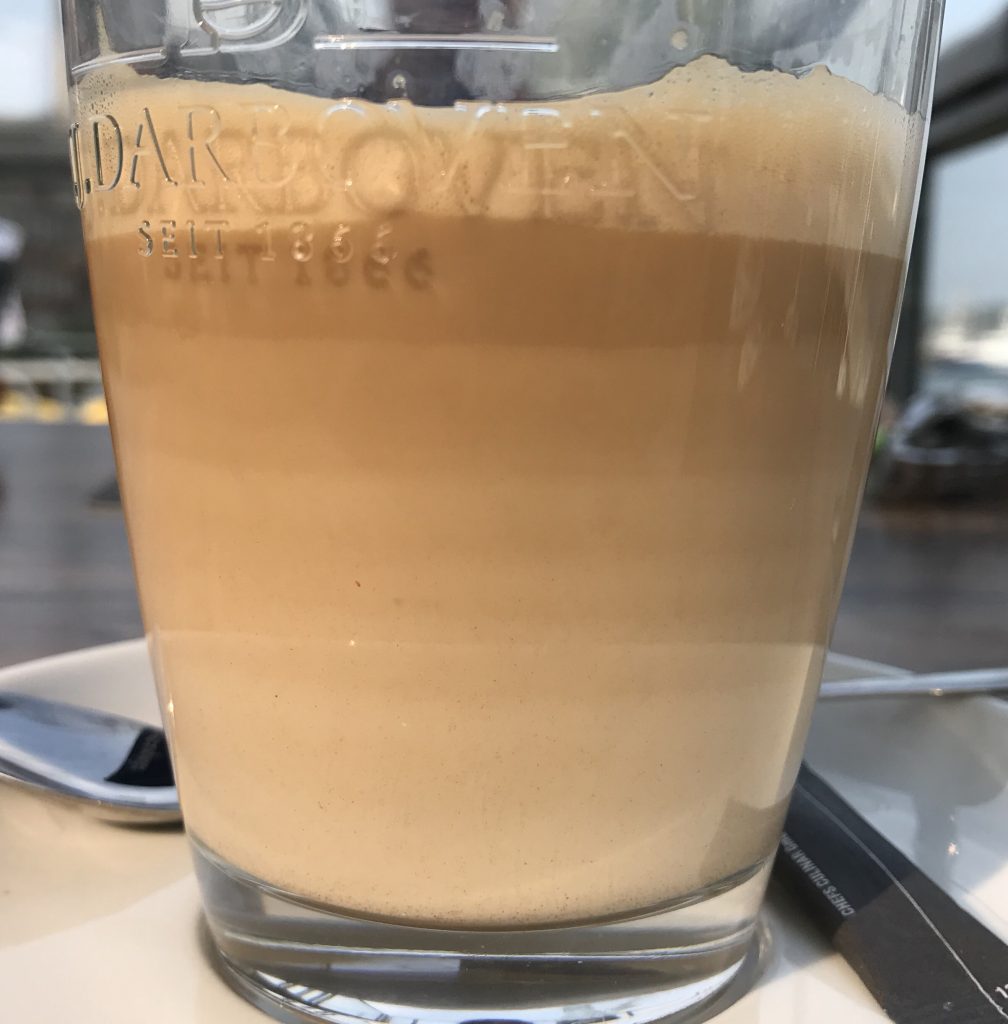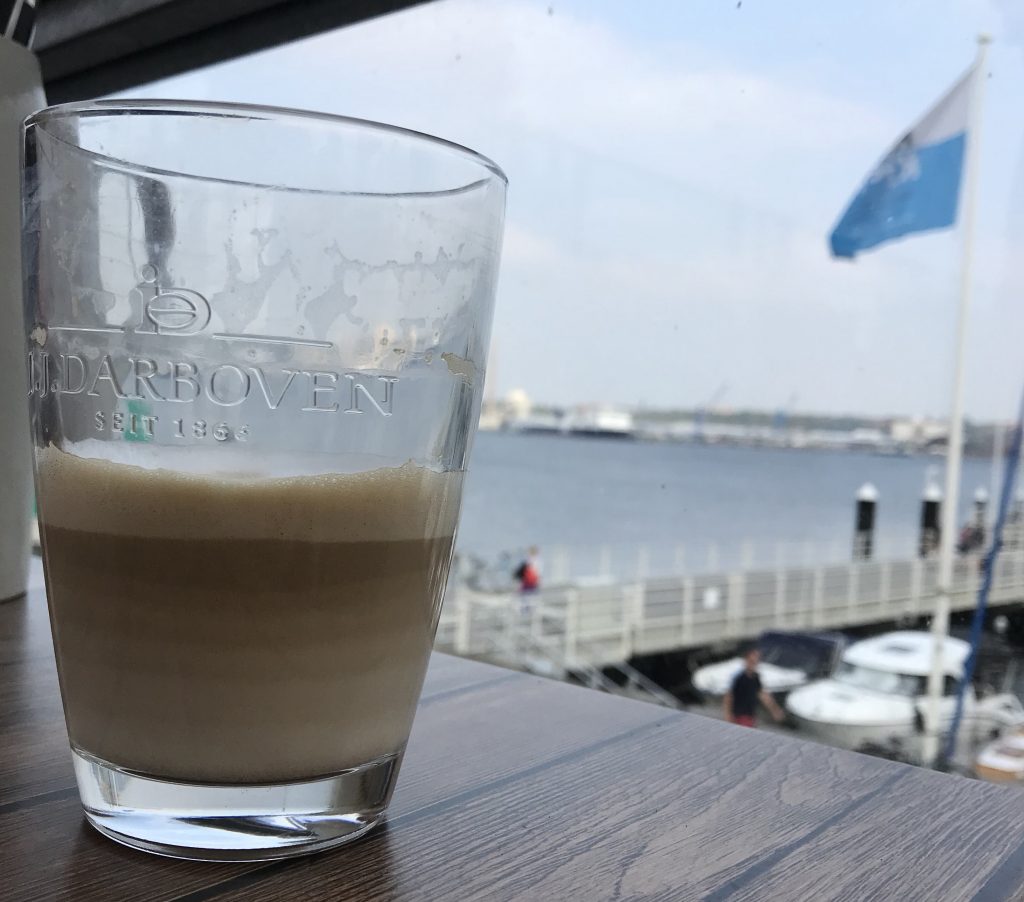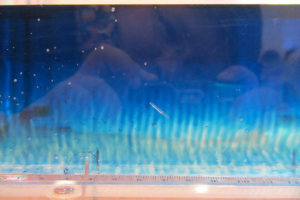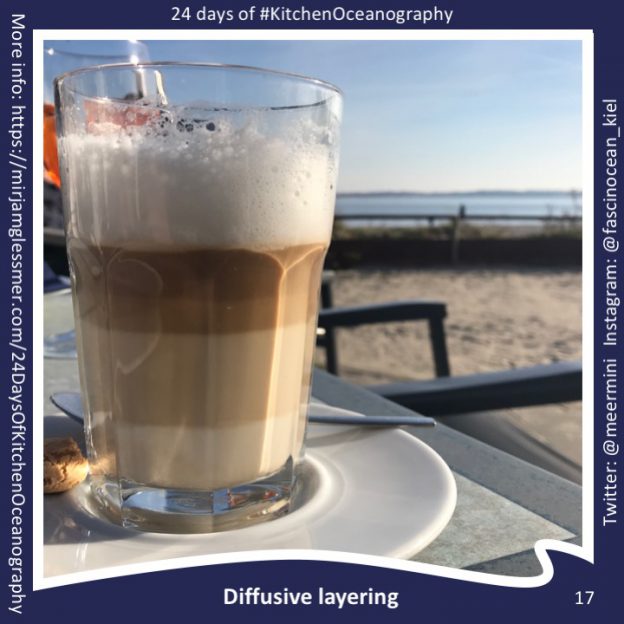
Tag Archives: diffusive layering

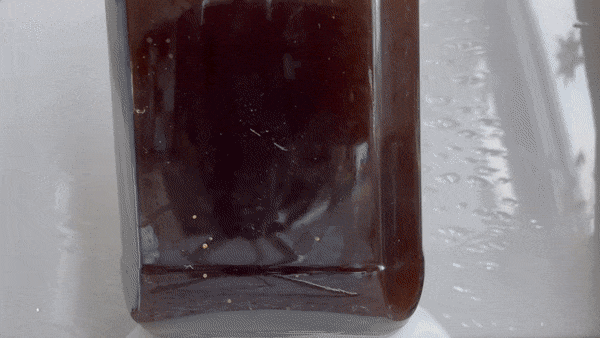
Diffusive layering — a super easy experiment!
Day 17 of my 24 days of #KitchenOceanography is about double-diffusive layering, and the post is using “go have a nice latte” as instructions. However, in times of Covid-19 (and a hard lockdown in Germany since Wednesday) that’s unfortunately impossible. And since Lars Henrik said that he was especially curious about this experiment, and today is the day of my “inaugural” lecture back at GFI in Bergen, I thought that was reason enough for a little upgrade to my advent calendar.
So here we go: Looking at diffusive layering in a coffee-and-milk scenario!
The experiment is SUPER easy. The only reasons you might not be aware of this happening are
- You don’t drink coffee in a glas
- You don’t add milk
- You stirr too much and/or too soon
- You drink the coffee too early
So. If you avoid all that, this is what you will see: A stratification with nice layers forming!
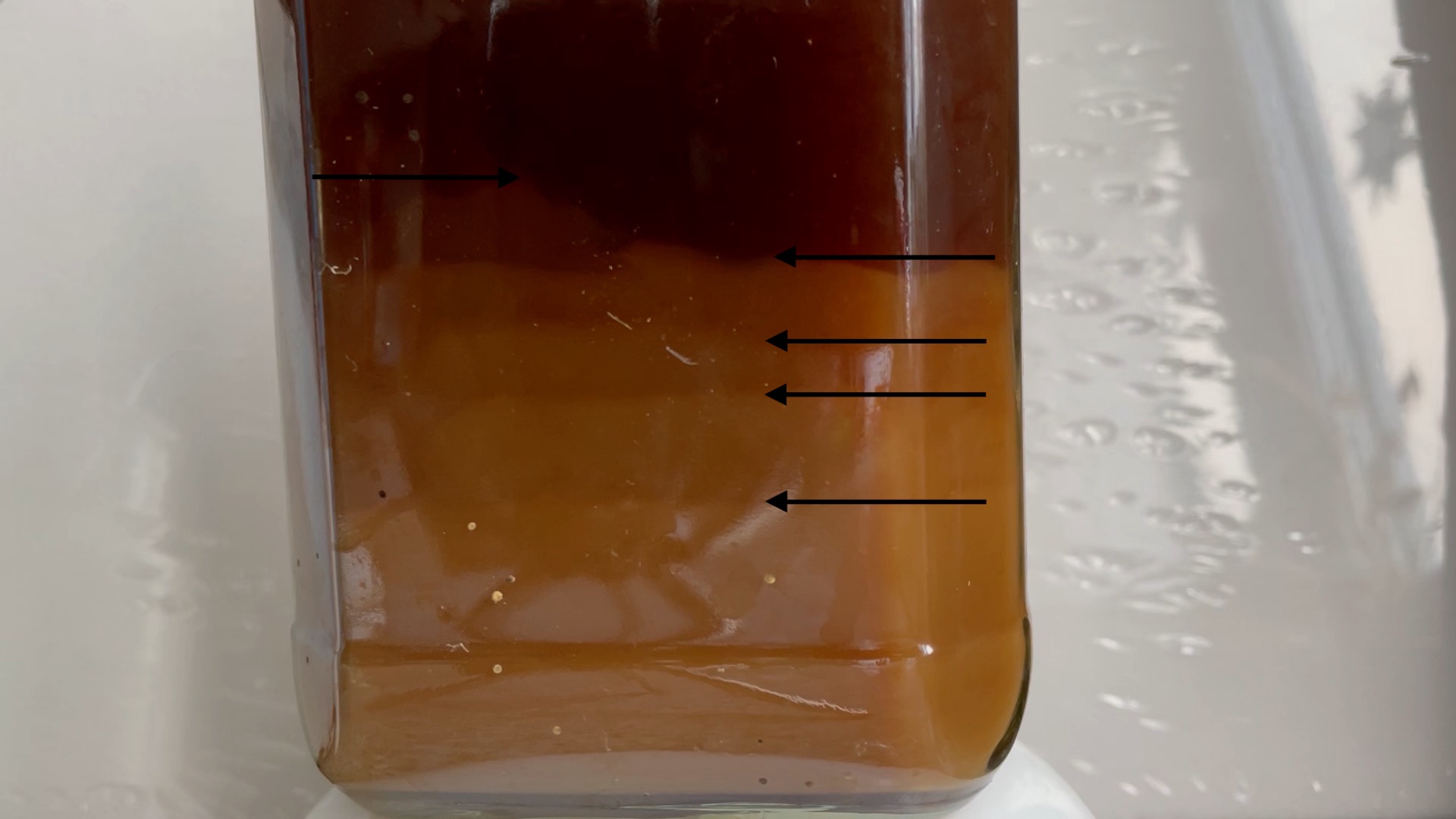
All you need to do is
- Make coffee
- Pour coffee into glass
- Drop a teaspoon or two of sugar into the glass (NO STIRRING RIGHT NOW!)
- Pour some milk into the coffee (don’t stress if it looks very turbulent, it’ll settle…)
- Observe layers forming!
- (Optional: When you feel like you’ve seen enough of those layers, stirr CAREFULLY so a little of the sugar gets dissolved into the lowest layers of the coffee-milk-mixture
- Observe a different set of layers forming)
That’s it! Awesome, isn’t it?
Here is a movie the full experiment:
What’s happening here is that cold milk is denser than hot coffee, therefore it sinks to the bottom. But at the interface, there is a fast transfer of heat and a much slower transfer of matter, so the milk gets warmed up and raises until it reaches a level of its own density (the new interface). Within that layer, properties are pretty much homogeneous, but at the interfaces above and below, there are gradients both in temperature and coffee/milk content (salinity in the ocean). So at each interface, a new diffusive layer will form. Over time, many layers develop.
When we stirr in the sugar after some time, we add a new dissolved substance that influences density, and we re-start the diffusive layering process.
Out-takes: Can you guess what happened here? (It does look super awesome, but why is the stratification being eroded?)
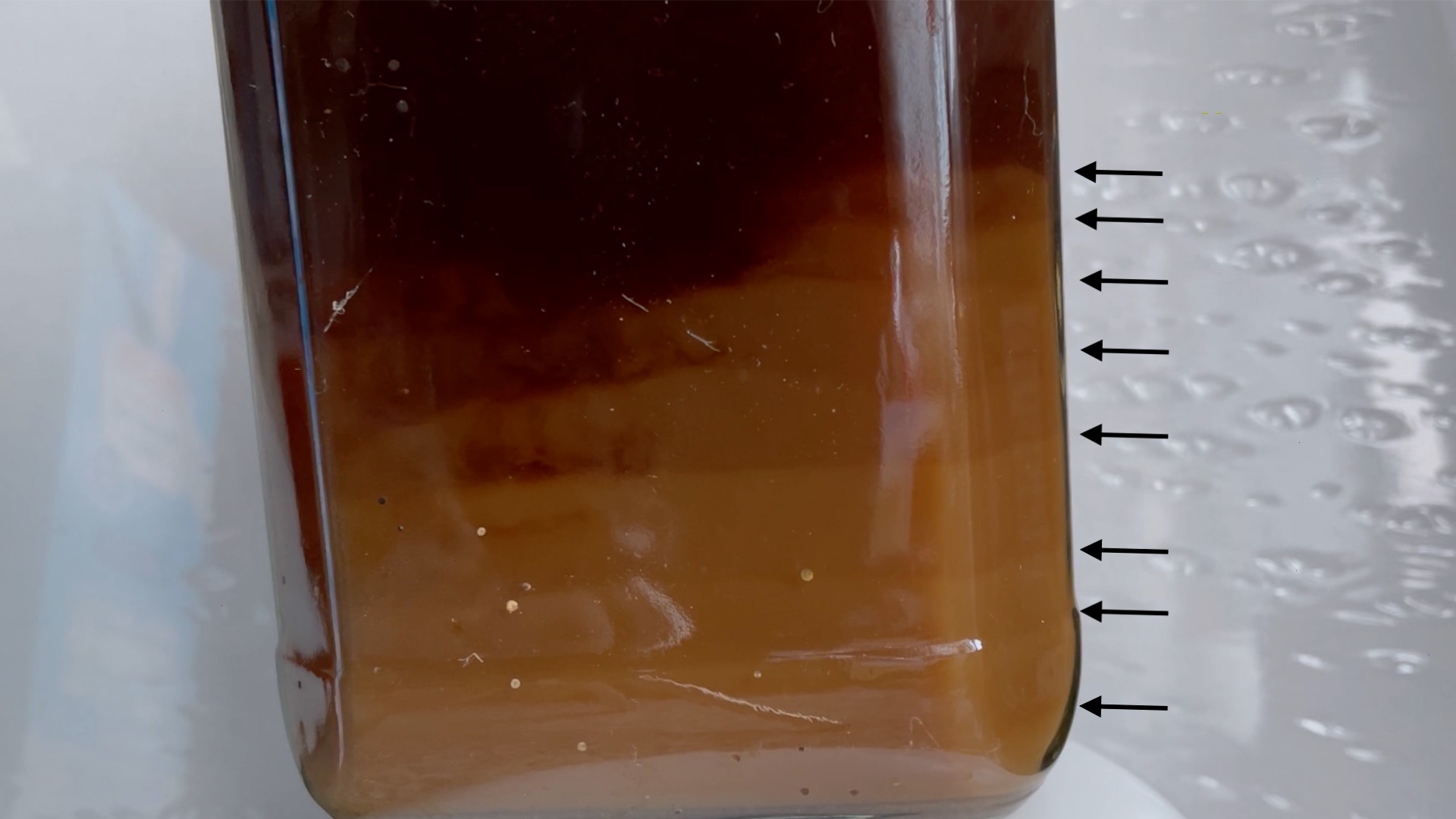
I can tell you. The first time I ran the experiment, some sugar stuck to the condensation inside the glass just above water (coffee?) level. As there was more and more water vapor rising from the coffee and more and more condensation collecting on the side of the glass, sometimes some of that sugar sinks down in dense plumes that break through some of the layers (but isn’t it awesome to see how the layers still catch some of the dense plume?!)
Check out the movie of that experiment, it’s awesome!
Layered latte: A great real-life example of double-diffusive mixing!
Sometimes sitting in a café for a work meeting with #lieblingskollegin Julia can lead to unexpected discoveries of oceanographic processes — in my latte! It’s those little things that inspire blog posts…
“Kitchen oceanography” brings the ocean to your house or class room!
Oceanography is often taught in a highly theoretical way without much reference to students’ real life experience. Of course a sound theoretical basis is needed to understand the complexity of the climate system, but sometimes a little “kitchen oceanography” — doing experiments on oceanographic topics with household items — goes a long way to raise interest in the kind of processes that are not easily observed in the real world. I’ve previously written a lot about simple experiments you can perform just using plastic cups, water, ice cubes, and a little salt. But sometimes it’s even easier: Sometimes your oceanography is being served to you in a cafe!
Oceanic processes can be observed in your coffee!
Have you ever looked at your latte and been fascinated by what is going on in there? Many times you don’t just see a homogenous color, but sometimes you see convection cells and sometimes even layers, like in the picture below.
But do you have any ideas why sometimes your latte looks like this and other times it doesn’t?
When you prepare latte in the right way, many layers form
Layers forming in latte (and in the ocean or in engineering applications) are an active research field! In the article “laboratory layered latte” by Xue et al. (2017), the authors describe that the “injection velocity” of espresso into the warm milk has to be above a critical value in order for these pretty structures to form in a latte. They even provide a movie where you can watch the layers develop over a period of several minutes.
The homogeneous layers with sharp boundaries are caused by double-diffusive mixing
Double-diffusive mixing, which is causing the formation of these layers, is the coolest process in oceanography. In a nutshell, double diffusive mixing is caused by two properties influencing density having different rates of molecular diffusion. These different rates can change density in unexpected ways and an initially stable stratification (high density at the bottom, low density on top) can, over time, become statically unstable. And static instability leads to adjustment processes, where water parcels move in order to reach the position in the fluid where they are statically stable — the fluid mixes.
But there are more fascinating things going on with the latte. Would you expect this stratification to remain as clearly visible as it is in the picture above even though the glass is now half empty? I did not! And then check out what happens when you move the glass: Internal waves can travel on the boundaries between layers!
You can use this in class to teach about mixing!
Mixing in the ocean is mostly observed by properties changing over time or in space, and even though (dye) tracer release experiments exist, they are typically happening on scales that provide information on the large-scale effects of mixing and not so much on the mixing itself. And they are difficult to bring inside the classroom! But this is where kitchen oceanography and experiments on double-diffusive mixing come in. If you need inspiration on how to do that, I’ve recently published an article on this (unfortunately only in German), but there are plenty of resources on this blog, too. Or shoot me an email and we’ll talk!
P.S.: Even though the coffee company is displayed prominently in the pictures above, they did not pay for my coffee (or anything else). But if they’d be interested and make me a good offer, I’d definitely write up some fun stuff on learning oceanography with coffee for them ;-)
“Laboratory layered latte” – combining latte and double diffusion. Easily my favourite paper ever!
My friends know me well. Especially A&I, which was proven again when they sent me the link to an article about two things that I am mildly obsessed with: Latte and double-diffusive mixing.
My obsession with latte is a fairly recent thing, but I have been known to blog about interesting convection pattern in it (for example here). The obsession with double-diffusive mixing, however, is well documented for more than the last 12 years (for example when I am writing experimental instructions, poems or scientific articles about it).
The double-diffusive process that I have been most concerned with is salt fingering, because it is oh-so-pretty, and also fool-proof to create for teaching purposes (when you know how to do it).
Diffusive layering I seem have to be a little frustrated with, at least in teaching (but reading back this post now, it turns out that that was entirely my own fault and not my students’. Oh well, you live and learn! Isn’t this exactly the kind of stuff that makes for great teaching portfolios? ;-)).
And it also turns out that I did the experiments themselves all wrong. According to the article “laboratory layered latte” by Xue et al. (2017). I should not have been trying to carefully stratify a tank in order to see diffusive layering. Instead, I should just have quickly poured the lower density fluid into the higher density one, and layers would have formed by themselves!
So there is one thing that you won’t see any time soon:
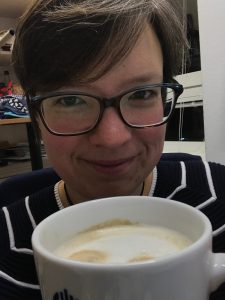
Yep. Me drinking latte from any kind of vessel that doesn’t let me look at the stratification! I don’t know how I could ever have fallen into the trap of missing out on observing fluid dynamics while having my early morning coffee in the office. Now I urgently need a nice glass mug!
And you should go check out the article, it’s a really nice read. My new ambition in life: Write a fluid dynamics research article that applies the FD to some really cool, yet mundane, every day thing. Are you in, Elin? :-)
—
Xue, Nan and Khodaparast, Sepideh and Zhu, Lailai and Nunes, Janine K. and Kim, Hyoungsoo and Stone, Howard A., Laboratory layered latte. Nature Communications 8(1), 2017
Diffusive layering. Or: This is not a trick question!
The “other” double-diffusive mixing process.
After having talked extensively about double diffusive mixing in my courses, I tend to assume that students not only remember that there is such thing as double-diffusive mixing, but that they also remember our discussions on how the process works, and that they would be able to transfer this to processes other than salt fingering.
So in two courses (at different universities) I asked students in the exam to describe what would happen in a stably stratified body of water, where cold and fresh water overlies warm and salty water. And in both courses I have been surprised (read: shocked) by the responses I got.
The by far most common response goes along these lines: “Cold water is denser than warm water, so it will sink to the bottom and the warm water will rise”.
What I find frustrating about this (besides the fact that they didn’t notice that I clearly stated in the question that the stratification was stably stratified) is that whenever I talked about density, I mention how density depends on both temperature and salinity.
The next most common response is then this: “Heat diffuses a factor 100 faster than salt. Hence, salt fingers will form at the interface”. This answer then continues on describing salt fingering and never even mentions that the stratification I described in the question was actually the opposite one to the one they are assuming. So here, students clearly jumped to the conclusion that if I bothered describing a stratification, it clearly had to be the one for my favorite process (even though during those discussions I made sure to mention diffusive layering, too, but without talking it through in as much detail as salt fingering).
But then there are always students (usually the ones who don’t have a lot of confidence in their oceanography skills) who take the questions I ask at face value. Those are the students who go on to write something like this (numbering referring to the sketch below):
1) The initial stratification is stable in density, with cold and fresh water over warm and salty water. This means that the salinity stratification outweighs the temperature stratification in terms of density.
2) Since temperature diffuses a factor 100 faster than salinity, a thin layer with an intermediate temperature will form around the interface in salinity, that will persist for a while.
3) Focussing above the interface now, we have a stratification where cold and fresh water overlies lukewarm and fresh water. This stratification is hence unstable in temperature and convective overturning will occur. Below the interface, a similarly unstable layer has formed: lukewarm and salty water over warm and salty water. Again, convective overturning will occur.
The thickness of those layers depends on the initial temperature stratification and on how quickly temperature exchange happens during the overturning. In the end, two new temperature interfaces will have formed.
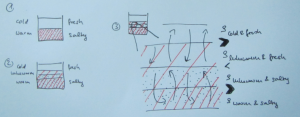
Sketch of the diffusive layering process. The red shading indicates warmer temperatures, the black dots indicate higher salinities.
And yes – that is exactly the response I wanted to hear!
So why do only so few students answer this question correctly? Don’t they understand that when I talk about salt fingering it is only an example of a double-diffusive process and not the only double-diffusive process there is? That was my initial thought after I saw the exams in the first class. So for the second class, I made sure to mention diffusive layering even more, and to explicitly say that I was talking through only one of the processes and that it might be helpful if they went through the other one on their own. Yet in the exams, the results did not change. And I have no idea. Do you? Then please let me know!
